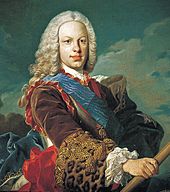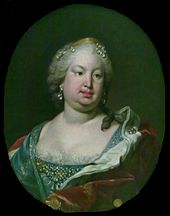Ferdinand VI. (Spain)
Ferdinand VI. of Spain (Spanish Fernando VI, born September 23, 1713 in Madrid ; † August 10, 1759 in Villaviciosa de Odón ) was King of Spain from 1746 until his death .
Life
Childhood and youth
Ferdinand VI. was born on September 23, 1713 in Madrid as the fourth son of King Philip V of Spain and his first wife Maria Luisa Gabriella of Savoy .
He had a lonely childhood far away from court, only accompanied by his older brother Ludwig . His stepmother Queen Elisabeth kept him away from inner court circles even after Ludwig's death and his rise to the throne. Even as Prince of Asturias, Ferdinand was not allowed to take part in the Spanish Council of State and so could not gain any experience in government work that would have prepared him for the assumption of the throne.
On January 19, 1729 he married the Portuguese Infanta Maria Barbara de Bragança . Although the marriage was purely politically motivated, Ferdinand and Maria Barbara were very fond of each other. The two shared a passion for music. The Italian Domenico Scarlatti was hired as the piano teacher of the Crown Princess and later Queen , whose famous 555 sonatas were probably composed primarily as practice pieces for Maria Barbara; in view of these works she must have been a talented musician.
The marriage remained childless.
Assumption of the throne
Ferdinand succeeded his father to the throne on July 9, 1746. Benevolent but weak, he left the government to those around him. In addition to his wife, this also included his favorite, the castrato Farinelli , who had already had considerable influence under the reign of Philip V.
At the Queen's instigation, Elizabeth's Italian courtiers lost their importance. Elisabeth herself withdrew to the widow's residence Palacio Real (Riofrio) . The Prime Minister Sebastián de la Cuadra y Llarena was soon dismissed and replaced by José de Carvajal y Lancaster . In contrast, the court left the Minister of War and Navy, Zenón de Somodevilla y Bengoechea , Marqués de la Ensenada, in office. With the death of Carvajal in 1754 Ricardo Wall came to the post of Prime Minister.
Domestic politics
The government officials under Ferdinand VI. tried to clean up the state finances and reform the country. The Marqués Ensenada, who was also responsible for the finance department, began work on a comprehensive tax reform that aimed solely at assets as a basis of assessment. In order to evaluate the property, he began in 1749 with the cadastral ; However, the project came to nothing after the nobility and clergy hindered it as best they could.
Ensenada also reformed the financial administration, and Spain was given its own bank for the first time, which took care of state disbursements and thus reduced the costs for bankers and intermediaries.
The relationship between church and state was reorganized by Prime Minister Carvajal in 1753 with a concordat that gave the crown greater powers in the ecclesiastical province of Granada and overseas.
In July 1754, the minister Zenón de Somodevilla, who had long determined Spain's political line, overthrew an intrigue by the British ambassador, Benjamin Keene .
Foreign policy
Ferdinand VI. In contrast to his father and stepmother, he did not pursue any personal or family interests in foreign policy. So his government tried a line of balance and neutrality between the European power blocs France and Great Britain / Austria . Prime Minister and Foreign Minister Carvajal as well as Minister of War Somodevilla thus achieved a period without costly armed conflicts.
The striving for balance found its expression in the Treaty of Madrid (1750) , in which Spain reached an agreement with long-standing rival Portugal on the drawing of borders in South America.
The tensions against the Austrian Habsburgs, against whom Spain had fought under Philip V in the War of the Austrian Succession for the possessions in northern Italy, were relieved by the marriage of Ferdinand's youngest sister, the Spanish Princess Maria Antonia, to the Savoy Crown Prince Viktor Amadeus .
Spain also achieved an equalization with Great Britain, which was laid down in the Treaty of Aranjuez (1752).
In the Seven Years' War from 1756, under the new Prime Minister Ricardo Wall, Spain took a neutral stance during Ferdinand's lifetime.
Late years and death
After the death of his wife in 1758, Ferdinand withdrew to Villaviciosa and surrendered to a gloomy melancholy that led to complete spiritual decline. Ferdinand died childless on August 10, 1759 in Villaviciosa de Odón.
ancestors
| Louis XIV , King of France (1638–1715) | |||||||||||||
| Louis de Bourbon Dauphin of France (1661–1711) | |||||||||||||
| Maria Teresa of Spain (1638–1683) | |||||||||||||
| Philip V King of Spain (1683–1746) | |||||||||||||
| Ferdinand Maria , Elector of Bavaria (1636–1679) | |||||||||||||
| Maria Anna of Bavaria (1660–1690) | |||||||||||||
| Henriette Adelheid of Savoy (1636–1676) | |||||||||||||
| Ferdinand VI. King of Spain (1713–1759) | |||||||||||||
| Charles Emanuel II Duke of Savoy (1634–1675) | |||||||||||||
| Viktor Amadeus II. Duke of Savoy (1666–1732) | |||||||||||||
| Maria Johanna of Savoy (1644-1724) | |||||||||||||
| Maria Luisa Gabriella of Savoy (1688-1714) | |||||||||||||
| Philippe I. de Bourbon, duc d'Orléans , (1640–1701) | |||||||||||||
| Anne Marie d'Orléans (1669–1728) | |||||||||||||
| Henrietta Anne Stuart (1644-1670) | |||||||||||||
swell
Web links
| predecessor | Office | successor |
|---|---|---|
| Louis of Bourbon and Savoy |
Prince of Asturias 1724–1746 |
Charles of Bourbon and Saxony |
| Philip V. |
King of Spain 1746–1759 |
Charles III |
| personal data | |
|---|---|
| SURNAME | Ferdinand VI. |
| ALTERNATIVE NAMES | Fernando VI. (Spanish) |
| BRIEF DESCRIPTION | King of Spain |
| DATE OF BIRTH | September 23, 1713 |
| PLACE OF BIRTH | Madrid |
| DATE OF DEATH | August 10, 1759 |
| Place of death | Villaviciosa de Odón |

